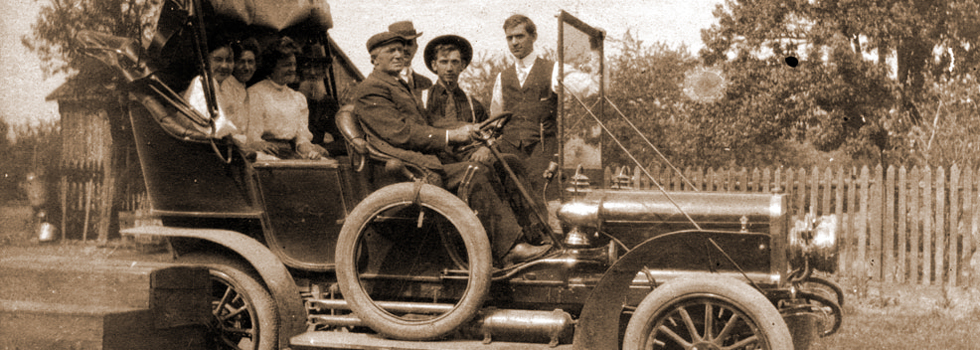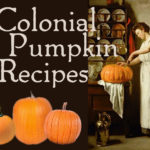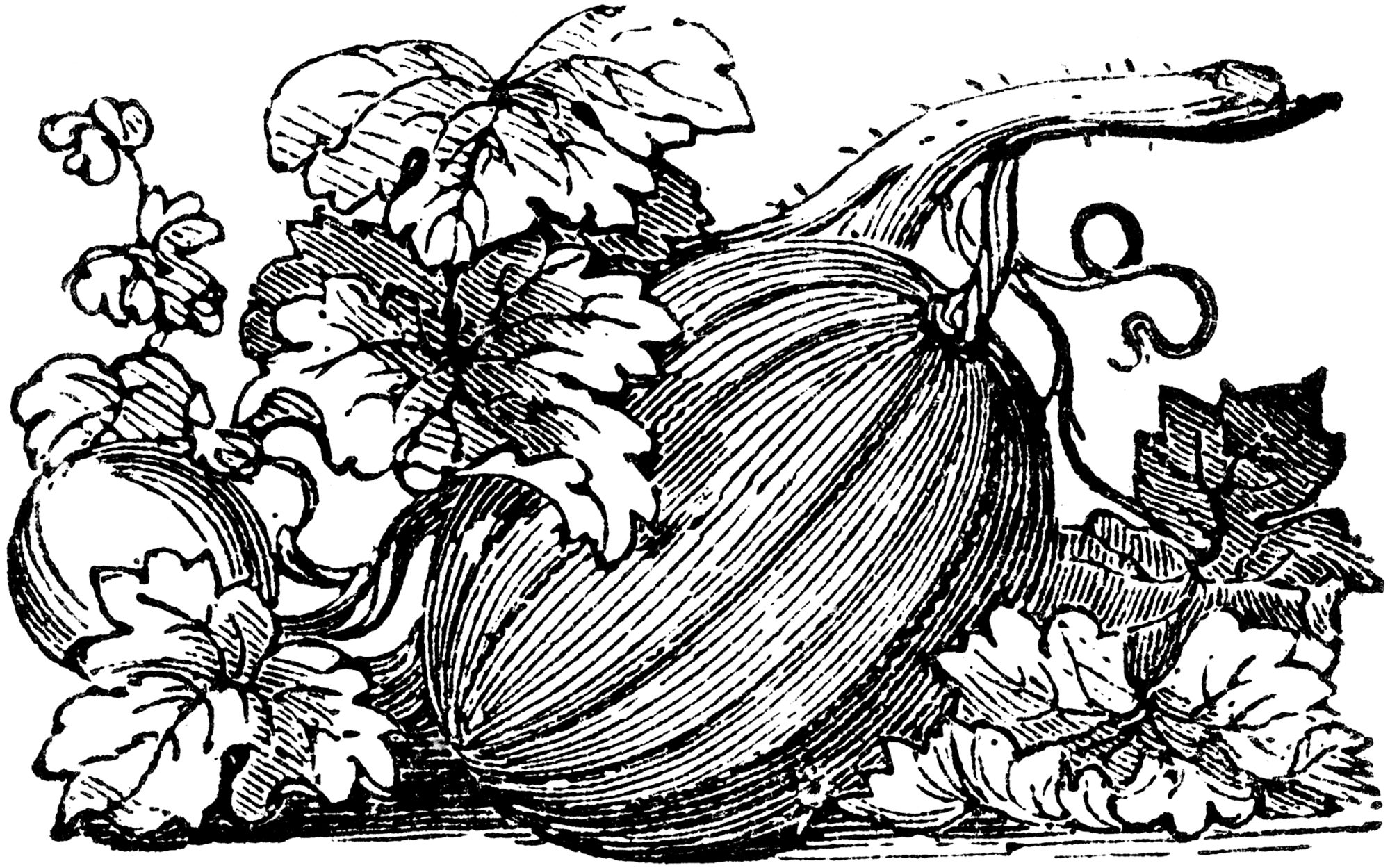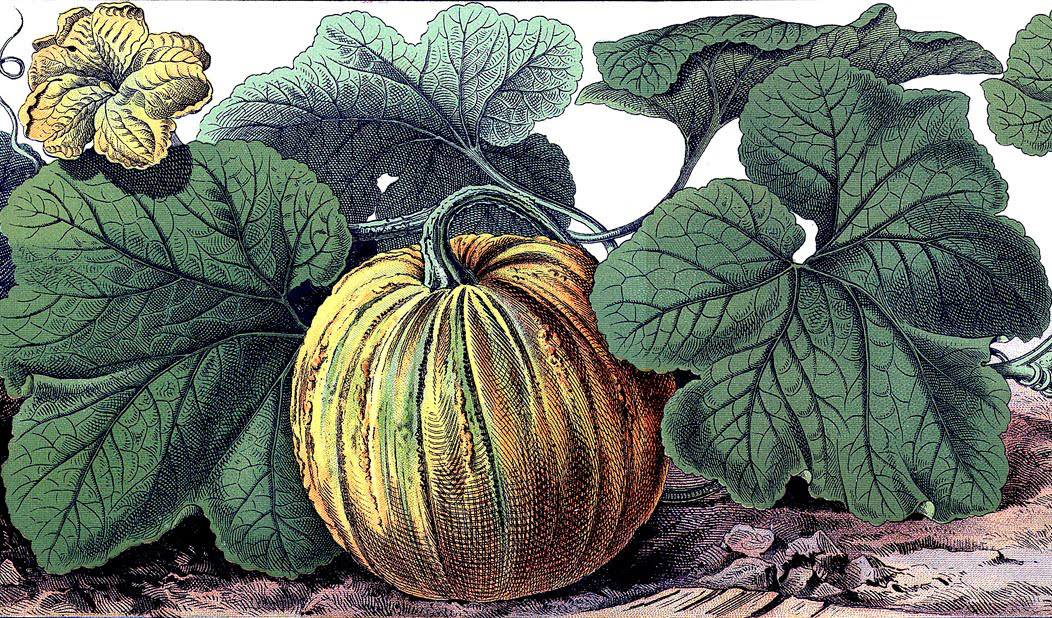“…slice them when ripe,and cut them into dice, and so fill a pot with them of two or three gallons, and stew them upon a gentle fire a whole day, and as they sink, they will fill again with fresh Pompions, not putting any liquor to them. When it is stew’d enough, it will look like bak’d apples. This they Dish, putting butter to it, and a little Vinegar with some Spice as Ginger, etc., which makes it tart like an Apple, and so serve it to be eaten with Fish or Flesh.” – John Josselyn, 1660
“We have pumpkins at morning, and pumpkins at noon,
If it were not for pumpkins we should be undone.”
The pumpkin holds a special place in early American history. Unfamiliar to the colonists, it was introduced to them by Native Americans and along with corn, cranberries, sweet potatoes, and blueberries, soon became a staple of their diet. Favored because it was easy to grow, cultivate, and keep, the settlers learned to plant the seeds between corn stalks, saving space and balancing the soil. Indians taught the settlers how to dry and string the pumpkins for winter use. Pumpkin may well have been valued at first for its protein and oil rich seeds. The pumpkin meat was most frequently made into a thin “pottage” by boiling and macerating it, then boiling it again with some of the water and a lot of milk, stirring constantly. Cooked pumpkin was also kneaded into dough with maize and other flours and formed into little cakes that were cooked on a griddle. Used widely in recipes, pumpkins were baked, made into breads, pies, soups, stews, puddings, dried for winter use, and even hollowed out, filled with sweetened milk and spices and baked before the fire, the meat to be eaten later with a spoon.
In 1682 Hannah Mooley published a recipe for “Pumpion-Pye,” but it bears no resemblance to our 20th century recipe. The first recipe for pumpkin pie as we know it is believed to have appeared in 1796 in the first cookbook written by an American, Amelia Simmons. Though called “Pompkin Pudding,” the dish was baked in a “paste” of crust. Pumpkin pie may well have evolved from the English idea of pie as a meat-filled pastry. The crust was first filled with pumpkin stewed “Indian fashion” to which English custard and some West Indian molasses were added. Peter Kalm, the Swedish naturalist, described the 18th century dish during a visit to Pennsylvania, making it sound more like a pumpkin flan or tart. “Slices of gooseneck pumpkin simmered in water or cider til soft were spiraled or stacked into tart pastry. A cream and egg mixture flavored with molasses and whiskey or rum was then poured over it.” The all American pumpkin pie had been born.
The “receipt” for an “Ancient New England Standing Dish” reads like a recipe for “pompion sause”: dice it, stew it all day long, add butter, a little vinegar, and “some spice as ginger which makes it tart like an apple and so serve it up to be eaten with fish or flesh.”
Pumpkins were commonly dried, sliced into rings and hung in the sun to dry before being stored for winter use. Dried pumpkins were then rehydrated with water during the winter to be used in stew, soup, or “sause” to accompany meats. Dried, they were used as sweetener in 18th century “bevriges” when sugar and molasses were too expensive. Unlike the fragrant, flavorful pumpkin bread served today, the “Pumpkin and Indian Mixt Bread” sampled by a traveller in the early 1700’s was described as “not pleasing in appearance” and “an awkward food.” Despite this bad review, pumpkins were served in some form at almost every meal, enriched with milk, butter, and eggs, and seasoned with molasses, maple sugar, cinnamon, ginger, or nutmeg.
Although Europeans considered pumpkin fit only for peasants, a 17th century American described pumpkin as “the fruit which the Lord fed his people with till corn and cattle increased.”
The English word pompion or pumpion had been in use at least since 1545; the American word pumpkin first appeared in print in 1647.
Recipes
Soups
Soup, that nourishing brew, was an important food for early Americans. It filled a hungry person’s stomach and was easily managed by both older and younger members of the household. Whatever food was available was put into the soup kettle.
Soups are never to be filled up or have even a drop of water, hot nor cold, added: and are never to boil briskly. They are to be long, long over the fire, simmering rather than boiling. And all soups having roots or herbs, are to have the meat laid on the bottom of the pan, with a good lump of butter. The herbs and roots being cut small are laid on the meat. It is then covered close and set on a very slow fire. This draws out all the virtue of the roots and herbs, and turns out a good gravy, with a fine flavour, from what it would be if the water was put in at first. When the gravy is almost dried up, then fill the pan with water: and when it begins to boil, take off the fat. – J. B. Bordley, Essays and Notes on Husbandry and Rural Affairs
Pumpkin Basil Chowder
This soup is easily made ahead of time and reheated. Fresh pumpkin works better than canned. Also try with fresh or frozen squash.
1 medium onion, finely chopped
2 cups pumpkin, cooked
1 tablespoon butter
1 quart freshly made chicken stock
1 can corn, with liquid
1/4 teaspoon salt
1/8 teaspoon freshly ground pepper
1 tablespoon brown sugar
1 cup light cream
2 tablespoons fresh basil, chopped
Optional: ham bone to flavor stock, 1/2 cup julienned ham
In large soup pot, lightly sauté chopped onions in butter. Add pumpkin and chicken stock. Blend together and add corn, seasonings, and optional ham bone and/or julienned ham. Heat until hot but do not boil. Add cream and freshly chopped basil. Let soup pot sit, covered, for five minutes before serving. (Basil flavor comes through more if chowder is made ahead and carefully reheated. The ham is a nice, but not necessary, addition.)
Pumpkin Peanut Soup
1 medium onion, chopped
2 ribs celery, chopped
2 cups pumpkin
3 cups chicken broth
¼ cup peanut butter
3 sprigs parsley, chopped
salt
pepper
freshly grated nutmeg
3 tablespoons butter
cloves
cream
In large kettle, melt 3 tablespoons butter; saute one medium onion, chopped, and 2 ribs celery, chopped. Add 2 cups pumpkin, 3 cups chicken broth, and ¼ cup peanut butter. Simmer 15 minutes. Add 3 sprigs parsley chopped; and salt, pepper, freshly grated nutmeg, and dash of cloves to taste. Before serving, add ½ cup light cream or finish off with a dollop of whipped cream.
Pumpkin-Apple Bisque
(adapted from a recipe served at the 18th century Red Lion Inn, Stockbridge, Massachusetts)
1 small pumpkin or butternut squash* (about 1 pound — peeled, seeded, and cut in large pieces)
1 onion, coarsely chopped
2 tart apples, peeled, cored, and coarsely chopped
sprig or pinch of rosemary and marjoram
1 quart well-flavored chicken stock
2 slices country white bread, trimmed and cubed
salt and pepper to taste
Combine all of the ingredients listed above in a large stockpot. Bring to the boil and simmer for 45 minutes, until the vegetables and fruit can be mashed. (20th century cooks may wish to puree the mixture; the colonial housewife would have had to do the job by hand.) Taste and adjust seasonings and thickness of bisque. More stock can be added to thin the bisque; cream or milk can be added to enrich it. For a festive presentation ladle heated bisque from a baked pumpkin shell.
*Frozen squash may be used in place of the fresh and added to the other ingredients to simmer for the last 15 minutes; however, the texture and flavor of the bisque will not be as rich. Canned pumpkin may be used but is less preferable.
Breads
A woman dressed in a chemise and shortgown reaches into the fiery hot beehive oven to pull out a dozen loaves of freshly-baked bread, sets them on a cloth to cool, then bends to reload the oven with a second batch, while a delicious aroma fills the air. Such was a typical scene in a colonial house where baking in the beehive oven was a once-a-week all-day affair. The cook arose early to start the fire since the earlier it was started, the more chance there was to finish by sunset. This very hot fire took two to three hours to heat, sometimes even four hours in the winter. After reaching the desired temperature, the coals were raked out and the oven floor cleaned with a wet swab. Breads were baked first when the beehive oven was hottest, then cinnamon buns, cakes, and pies. As the oven cooled, muffins and “biscuits” were baked, then puddings and custards. Even after a day’s baking there was still sufficient heat to dry apples and other fruits as well as vegetables and herbs. A pot of beans may have been placed in the back of the oven to cook slowly overnight.
Pumpkin Apple Bread
1 1/2 cups unbleached flour
1 teaspoon baking soda
1/2 teaspoon ground cloves
freshly grated nutmeg to taste
1/3 cup vegetable oil
2 large eggs, lightly beaten
1/4 teaspoon salt
1 scant teaspoon cinnamon
1/8 teaspoon ground allspice
8 ounces of canned pumpkin
1 1/8 cups honey
1 cooking apple, peeled and chopped (about 1 cup)
Heat oven to 350 degrees. Butter a 9”x5”x3” loaf pan. In large bowl, sift together the first six dry ingredients. (Stir in freshly grated nutmeg; it doesn’t sift well.) In separate bowl, whisk together the pumpkin, oil, honey, and eggs. Add the flour mixture to the pumpkin bowl, stirring until the two mixtures are well combined. Fold in the chopped apple. Bake the loaf for 50 minutes or until a straw comes out clean. Let loaf cool in pan, about 45 minutes. Remove from pan and allow to cool completely. The bread keeps well when tightly wrapped. Yield, one loaf.
Pumpkin Bread
1 cup corn oil
4 eggs, beaten
2/3 cup water
2 cups canned pumpkin
3 1/3 cups sifted flour
1 1/2 teasoons salt
1 teaspoon nutmeg
1 teaspoon cinnamon
2 teaspoons baking soda
2 cups sugar
1 cup golden raisins
1 cup nuts, chopped
Grease and flour two long loaf pans, or three 8”x5”x3” loaf pans. Mix corn oil, eggs, water, and pumpkin. Add flour, salt, nutmeg, cinnamon, baking soda, and sugar. To the combined mixture, add raisins and nuts. Bake for 1 hour at 350º.
Historically, the culinary pumpkin of southeastern Pennsylvania has been the winter crookneck (gooseneck) pumpkin, known for its fine texture and good keeping qualities. What we think of as pumpkin —- the jack-o-lantern, the round “cow” or field pumpkin — was used as fodder for animals.
Desserts
Custards were popular because of the easy availability of eggs. One of the first recorded recipes for pumpkin pie, in pudding form, called for one quart stewed and strained “pompkins”, 3 pints cream, 9 beaten eggs, sugar, mace, nutmeg and ginger. The ingredients were then “laid into paste” and the cook instructed to take a “dough spur, cross and chequer [the pie], and bake in dishes three quarters of an hour”.
Pumpkin Ice Cream
Early Americans enjoyed ice cream, just as we do today. Thomas Jefferson wrote instructions for making ice cream and George Washington bought an ice cream maker. With the advent of ice houses, this became a treat available to many.
2 egg yolks
1/3 cup sugar
2 egg whites, stiffly whipped
1 cup cream, whipped
2/3 cup milk
1 cup canned pumpkin
1/2 teaspoon vanilla
1/3 cup brown sugar, packed
1/2 teaspoon salt
1/2 teaspoon cinnamon
1/2 teaspoon nutmeg
1/2 teaspoon allspice
1/4 teaspoon ginger
Beat the egg yolks and the sugar together. Fold in the egg whites then the whipped cream. Combine the remaining ingredients and mix gently into the egg mixture. Freeze in a refrigerator tray until partially set. Stir, then freeze until almost firm. Serves 8.
Baked Pumpkin
1 small pumpkin, cleaned and scraped (top cut off and set aside)
milk or light cream
about 3 tablespoons butter
1 medium onion, grated
3 tablespoons honey, brown sugar, or maple syrup
salt to taste
freshly grated nutmeg
Fill pumpkin half full with milk and other ingredients. Put pumpkin top back in place. Bake at 350º until the pumpkin is soft when tested with a fork, about 1 ½ hours. Set in the center of the table and scoop pumpkin out onto each plate with a wooden spoon. Season with more salt and butter. Freshly grated nutmeg may be added.
Pumpkin Pie
1 1/2 cups pumpkin
3/4 cup brown sugar, firmly packed
1/2 teaspoon fresh ginger root, grated
1 teaspoon freshly grated nutmeg
1/2 teaspoon salt
1 cup heavy cream
3/4 cup milk
1/4 cup dark rum, or brandy
3 eggs, lightly beaten
pecans
whipped cream
10-inch pie shell, unbaked
Mix all ingredients together and pour into the prepared pastry shell. Bake at 425º for 10 minutes. Reduce heat to 350º and bake for 40 minutes more, or until a knife inserted in center comes out clean. Garnish with pecans and whipped cream flavored with rum or brandy.
Other Recipes
Pumpkin Fritters
2 cups pumpkin
2 cups brown and white sugar, mixed
2 eggs
1/2 teaspoon salt
1/2 teaspoon baking powder
1/2 teaspoon vanilla
1/2 teaspoon ginger
1/2 teaspoon nutmeg
1/2 teaspoon cinnamon
1 1/2 cups plain flour (more if mixture is too moist)
Cream sugar, eggs, flour, salt and spices together well. Add pumpkin and vanilla. Mix well. Then add baking powder. Fry in a hot tablespoon of margarine or lard in spyder (three-legged cast iron pan) until brown. Sprinkle powdered sugar on top before serving. Makes 18 fritters – using a tablespoon.
Pumpkin Muffins
1 teaspoon baking soda
2 cups white flour
2 cups yellow cornmeal
2 tablespoons baking powder
2 teaspoons salt
1/8 teaspoon nutmeg
1/2 cup liquid honey
1/2 cup light molasses
1 cup canned or cooked pumpkin
3 well-beaten eggs
1/2 cup melted butter
2 cups buttermilk
Sift together the flour, cornmeal, baking soda, baking powder, and salt. Beat the eggs well. Add the pumpkin, honey, molasses, and buttermilk and mix. Add the sifted dry ingredients and beat with a spoon until well mixed. Stir in melted butter. Fill well-greased muffin tins 2/3 full and bake in preheated 425° to 450° oven until nice and brown or for 18 to 20 minutes. Serve hot.
Pumpkin Chutney
Try it at home for Thanksgiving!
2 1/2 pounds fresh pumpkin meat
2 pounds brown sugar
1/2 pound seedless raisins
juice of 1 lemon
2 1/2 cups malt vinegar
2 tablespoons grape juice
4 ounces finely chopped onions
4 bay leaves
1 teaspoon ground ginger
1 teaspoon white pepper
2 teaspoons salt
1/4 teaspoon freshly grated nutmeg
Mix ingredients in large bowl. Cover and leave to rest for 3 hours. Place in large kettle and simmer gently until pumpkin is tender. Then allow mixture to boil until liquids have reduced and consistency is fairly dense. Pot and seal.
Pumpkin Chips
1 firm, medium-sized pumpkin
1 cup sugar to each 2 cups chips
juice and rind of 12 lemons
2 to 3 ounces crystallized ginger
Peel the pumpkin, remove strings and seeds, and cut into 1-inch strips; then slice these strips very thin. Measure amount of chips and add half as much sugar to the juice of 12 lemons. Stir well. Add pumpkin chips to the sugar and lemon juice mixture and let stand overnight. Slice the lemon rinds into very thin 2-inch-long strips. Barely cover with water and simmer gently until soft. Drain and refrigerate overnight. The next morning, boil the chips in lemon juice and sugar until the chips are clear and transparent. Remove the chips and boil syrup 10 minutes longer, or until it begins to thicken; then add chips, lemon rind, and crystallized ginger to taste. Bring to a boil. Pour into jars and seal. Makes 6 to 8 pints.




TrackBack URL
https://www.karenfurst.com/blog/colonial-pumpkin-recipes/trackback/